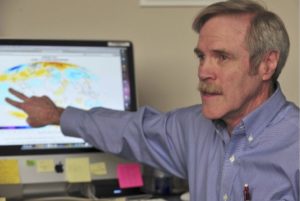by François Gervais, 6 juillet 2019 in LaSynthèse.OnLine
La vague de chaleur ayant traversé la France lors de la dernière semaine de Juin 2019 a donné lieu à une prolifération d’âneries proférées par certains médias, ainsi que, malheureusement, par certains hommes politiques. Les mêmes qui refusaient de prendre en compte les records de froid de l’hiver 2018-2019 dans l’hémisphère Nord, le record de surface de la banquise dans l’Antarctique du 21 septembre 2014 et le record de froid près du Pôle Sud (-98°6 C en 2018), en disant « Ne mélangez pas météo et climat » se sont mis frénétiquement à brandir des records de chaleur comme des scalps, oubliant au passage le bon conseil qu’ils donnaient eux-mêmes il y a 6 mois… Cette augmentation de la variabilité des températures, qui revient régulièrement dans l’histoire du climat de la Planète Terre, est un phénomène naturel où l’Homme, monté sur ses ergots, joue un rôle bien plus faible que clamé urbi et orbi par ceux qui s’enrichissent, au sens propre, du « climat de peur » qu’ils génèrent.
Pour nourrir le débat de faits scientifiques, recensés par des études menées par des scientifiques renommés, dont les références sont citées sur chaque slide, nous avons demandé à M. François Gervais, ancien Directeur de l’UMR 6157 du CNRS, et expert reviewer du rapport AR5 du GIEC, l’autorisation de reproduire sur La Synthèse les 52 slides projetées lors d’une Conférence qui eut lieu le 13 décembre 2018 (NDLR).
-
Pour accéder aux 52 slides, résumant les enjeux de la transition énergétique, merci de cliquer sur le premier lien en bas de page.
-
Pour accéder à la biographie de M. François Gervais, auteur de plus de 230 publications dans des revues scientifiques à comité de lecture, cliquer sur le deuxième lien en bas de page.
-
Pour assister à la Conférence du 13 décembre 2018, cliquer sur le lien ci-dessous (durée : 59 minutes) :


